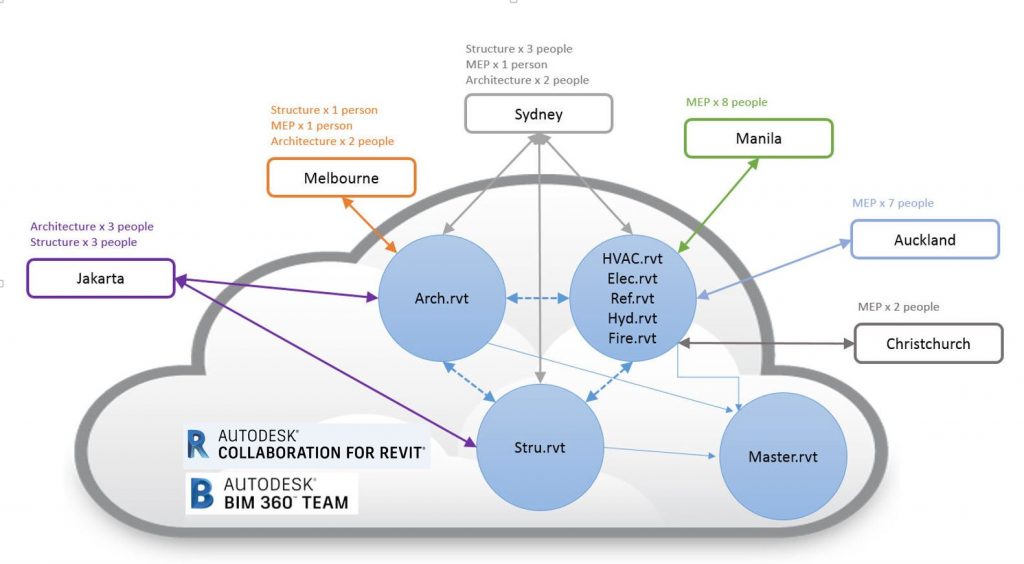With cloud-enabled Revit collaboration, Beca – one of Asia Pacific’s leading professional consultancies– connected workers across six time zones and added hours to its workday.
In the spring of 2016, Beca took on a job using Revit software to design an $80 million food factory expansion in Sydney, Australia. Company officials knew that the architectural and engineering work represented at least a 12-week job, but Beca only had eight weeks to complete the work.
A Tight Timeline
“We had a very tight timeline to get design documentation out,” recalls Craig Lamont, Business Director in Beca’s buildings business. “And the only way we were going to be able to do that time-effectively was to use our external offices.”
The firm has around 3,200 employees in 20 offices across the Asia-Pacific region, and also collaborates with documentation firms in Indonesia and the Philippines. Working with these firms brings cost efficiencies to large design projects, but can also present drawbacks, including time wasted uploading and downloading shared models and risk of extensive rework. Beca has experience in implementing many different collaboration solutions with various capabilities, however they weren’t appropriate for this particular project.

Craig Lamont, Business Director at Beca
“We needed something that would stretch our workday to fifteen hours and help us meet our design timeline.” Lamont says “So we sat down and explored — what could we do to take advantage of the time zone span between New Zealand and Indonesia?”
Breaking Down Barriers
To loop in offices across six time zones, Beca subscribed to Autodesk Collaboration for Revit for each of the 33 people working on the food factory project. The cloud-based Revit collaboration service provides centralized access to Revit models, and allows project team members from multiple sites to co-author Revit models regardless of each person’s physical location. This cloud-enabled worksharing also let team members see each other’s work and communicate with one another in real time. Their subscription also included access to Autodesk BIM 360 Team—the cloud platform on which Collaboration for Revit is built—which provided cloud storage, file sharing, design review and communication tools for all stakeholders.
On previous projects, workers in one office would upload a model at the end of the day, handing it off to team members who would download it in another location. Collaboration for Revit enables a smoother handover by allowing multiple offices to be in the model at the same time. The teams can then communicate while looking at the same information, reducing risk of misunderstanding and error.

Beca connected Revit teams across six time zones with Collaboration for Revit
“We didn’t have any of those issues with Collaboration for Revit, because we were able to work together with external offices,” says Lamont. “The team would start work in New Zealand in the morning, we’d get Australia going two hours later, and then we could bring our Indonesia and Manila resources on board before we went home at the end of the day. They knew exactly what we wanted them to work on and what the design deliverables were for the day.”
“It saved massive amounts of time and effort,” says Brett Naylor, Group Digital Delivery Manager for Beca. “We no longer needed to upload and download the model, and our people in overlapping time zones could work on the project simultaneously.”

Brett Naylor, Group Digital Delivery Manager, Beca
Workers on the project spoke three different primary languages, and Lamont says that the Revit collaboration solution helped to minimize confusion. “We could click and point and talk about exactly what we wanted drafted and where,” he says. “Being able to have everyone see the same thing in Revit at the same time helped overcome the language barrier.”
Each week, the team published the latest version of the model to BIM 360 Team, allowing them to share the design work with stakeholders who were not active in the Revit models.
Engagement and Accountability
Prior to deploying Collaboration for Revit, Beca would fly employees to offices in Manila and Jakarta to formally train workers there. “It was costing us a fortune,” says Lamont. “Now, with Collaboration for Revit and the Communicator tool, people can connect virtually, inside the model, and there’s training happening on-the-job, almost as if people are sitting next to the person in Sydney or Melbourne.”
Increased visibility also led to greater accountability, Lamont says. “We could see who was working on the job at any given time. Communicator allowed the team leads to see who was working in the model and give reassurance that the project was appropriately resourced.”
Reducing Rework
“There was nowhere near the amount of rework we would normally experience on a project of this size, especially at the speed that the job had to be completed,” says Clive Lumsden, job lead draftsman at Beca. “I could see exactly what remote workers were doing, and I was able to pick up issues before they became a problem, rather than waiting three days to get the model back. It just makes your life so much easier, and we saved money on the rework, too.”
At one point during the project, designers in remote offices began mistakenly drafting ductwork within the architectural environment. The Design Lead immediately caught the error and was able to redirect the modelling team to back out of the wrong model. “Catching an error like that would normally come with a lag of a week,” says Lamont. “Collaboration for Revit removed that latency.”
Overcoming Obstacles
“The challenge we have with a lot of other collaboration platforms is, they have to be within the Beca firewall,” Naylor says. “We can get around that, but at a high cost and timely setup. What we really liked about Collaboration for Revit was the ability to incorporate people outside our firewall environment, without adding a lot of setup time or changing our IT configuration. This allowed us to operate in a high trust environment and thereby further cement the relationship with our contracted partners.”

Beca connected Revit teams with Collaboration for Revit
Before fully deploying Collaboration for Revit, Beca tested the tool, sharing some of its largest architectural and engineering models between offices to see how the software performed in real-world situations. “It was a pretty quick learning curve,” Lamont says. “If you knew Revit, you could use Collaboration for Revit.”
‘Immeasurable’ Benefits
Lamont is blunt about the impact that Collaboration for Revit has had on Beca’s work, particularly on the initial food processing facility design. “If we didn’t have Collaboration for Revit, we would not have made the design timeline,” he says. Only because of the 15-hour workday enabled by improved Revit collaboration, Lamont says, was Beca able to complete a three-month project in only eight weeks.
“The benefits are almost immeasurable,” Lamont says. “It worked out that the cost of deployment was only a few hundred dollars for the duration of the job, and we achieved a return-on-investment very quickly through the reductions in rework alone.”
“It was an incredibly cost-effective solution,” Lamont adds. “With the time it saved, it was just a no brainer.”
Learn more about getting started with Collaboration for Revit and BIM 360 Team.
Article written by Calvin Hennick